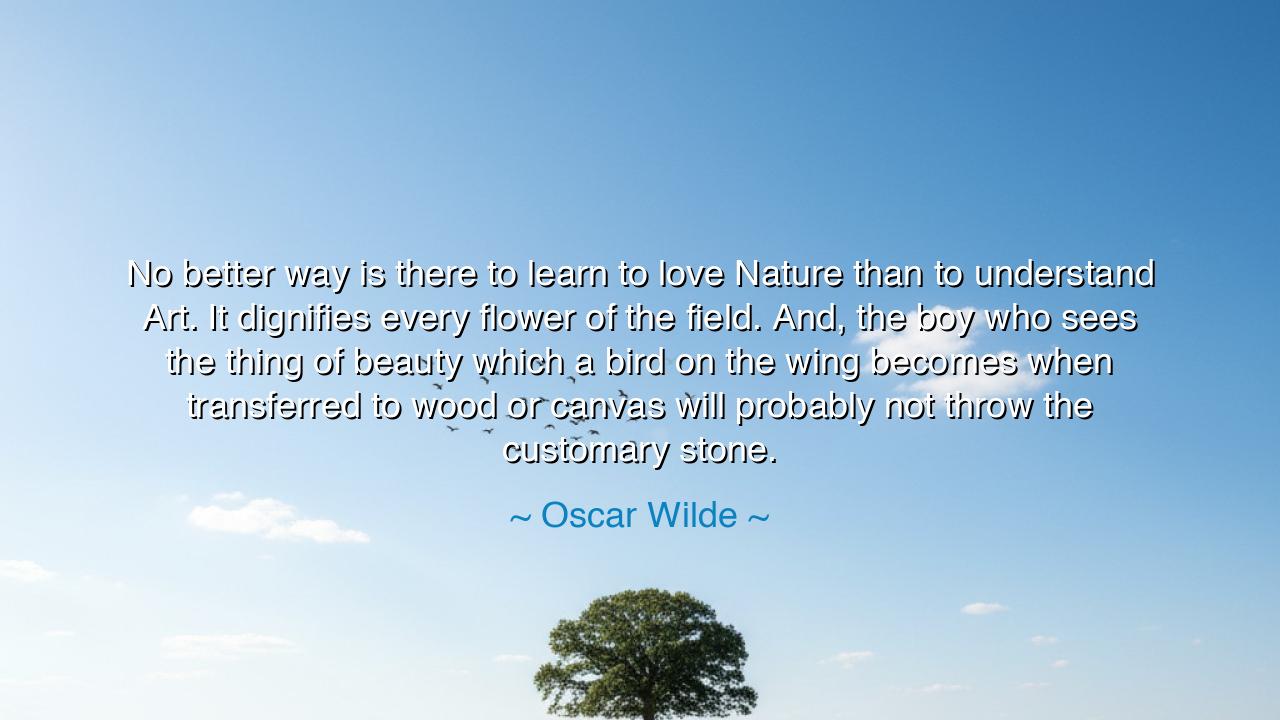
No better way is there to learn to love Nature than to
No better way is there to learn to love Nature than to understand Art. It dignifies every flower of the field. And, the boy who sees the thing of beauty which a bird on the wing becomes when transferred to wood or canvas will probably not throw the customary stone.






When Oscar Wilde declared, “No better way is there to learn to love Nature than to understand Art. It dignifies every flower of the field. And, the boy who sees the thing of beauty which a bird on the wing becomes when transferred to wood or canvas will probably not throw the customary stone,” he unveiled a profound truth about the transformative power of art. To Wilde, art was not a mere imitation of the world—it was a lens that ennobled it, teaching the eye to see what the heart might otherwise overlook. By translating the fleeting grace of nature into enduring form, art awakens reverence where once there was indifference.
The origin of this wisdom lies in Wilde’s belief in aestheticism, the idea that art has the power to elevate the human spirit by cultivating sensitivity to beauty. For him, art dignifies nature by teaching us not simply to glance at a flower or a bird, but to perceive them as miracles of form, light, and motion. Without art, the boy sees only a common bird and casts a stone in boredom or cruelty. With art, the boy sees majesty, fragility, and meaning—and his hand falls open, disarmed by wonder. Thus, Wilde suggests that art is not separate from morality; it is a hidden teacher of compassion.
History offers us shining examples of this truth. Consider John James Audubon, whose paintings of birds in the wild did more than please the eye; they awakened generations to the beauty and fragility of avian life. Before his work, many saw birds merely as game or nuisance. After his work, birds were revered as subjects of beauty and study. In this way, art transformed perception, and perception transformed conduct. Just as Wilde predicted, those who once might have cast stones instead learned to cherish.
The ancients also bore witness to this bond between art and reverence. The Greeks believed that beauty itself had a moral quality, and that to contemplate the statue of Apollo or the poetry of Homer refined the soul. Plato argued that art could lead the mind upward toward the forms of truth and goodness. Wilde’s vision resonates with this ancient teaching: by beholding the world through the artist’s hand, the soul is lifted into greater harmony with life itself.
The meaning of Wilde’s words is thus both tender and powerful. He shows us that cruelty often springs from blindness, from a failure to perceive beauty. When the eye is trained by art to see the sacred in the natural, the heart follows with gentleness. The boy who once saw only a target now sees a creature of splendor; he refrains from violence not because of command or punishment, but because his soul has been transformed. This is the quiet revolution of art: it changes not only what we see, but how we act.
The lesson for us is clear: cultivate your eye for beauty, for in doing so you cultivate compassion. Visit museums, read poetry, listen to music, study paintings—not to escape reality, but to train yourself to see reality more deeply. Let the artist’s vision dignify what you might otherwise dismiss. For when you learn to see the extraordinary in the ordinary, you will find cruelty impossible and reverence inevitable.
Practically, let us live this teaching by engaging with both nature and art. Walk in the field and look at the flower not as a weed, but as a masterpiece. Watch a bird in flight and imagine how a painter might capture its motion. And when tempted toward carelessness, recall Wilde’s boy with the stone: ask yourself, “Do I see beauty here, or do I see nothing?” In choosing to see beauty, you choose compassion.
Thus Wilde’s words endure as a hymn: art is the teacher of reverence, the mediator between the human soul and the grandeur of nature. It is art that opens the eye, art that restrains the hand, and art that teaches the heart to love. To understand art is not a pastime, but a sacred path—one that leads us to honor every flower, every bird, every breath of creation.






AAdministratorAdministrator
Welcome, honored guests. Please leave a comment, we will respond soon